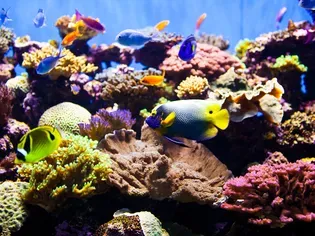Removing Brown Diatom Algae From Saltwater Aquariums
Updated on 04/26/24

Conquer Brown Diatom Algae: A Comprehensive Guide to Pristine Saltwater Aquariums
Brown diatom algae, a common nuisance in saltwater aquariums, can mar the beauty of your underwater paradise. But fear not, for this comprehensive guide will arm you with the knowledge and strategies to banish this pesky invader and restore the clarity of your marine haven.
Understanding Brown Diatom Algae
Diatoms, single-celled algae enclosed in intricate silica shells, are a natural part of the aquarium ecosystem. However, an overgrowth of brown diatom algae can be unsightly and negatively impact the health of your inhabitants.
Causes of Diatom Overgrowth
* Nutrient imbalance: Excess nitrates and phosphates, often caused by overfeeding, can fuel diatom growth.
* Insufficient filtration: A weak filter system can fail to remove diatom cells from the water.
* New tank syndrome: Diatom algae often bloom in newly established aquariums as the ecosystem stabilizes.
Hazards of Brown Diatom Algae
* Aesthetic impairment: Brown algae can cloud the water and cover aquarium surfaces, detracting from the beauty of your reef.
* Competition for nutrients: Diatoms can outcompete corals and other organisms for essential nutrients.
* Oxygen depletion: In severe cases, diatom blooms can deplete oxygen levels, harming fish and invertebrates.
Prevention Strategies
* Control nutrient levels: Monitor nitrate and phosphate levels regularly and perform water changes as needed to keep them within optimal ranges.
* Establish a strong filtration system: Invest in a high-quality filter system capable of removing diatom cells and providing adequate water flow.
* Avoid overfeeding: Excess nutrients from uneaten food can contribute to diatom growth. Feed your fish and invertebrates only as much as they can consume in a few minutes.
Treatment Options
1. Manual Removal
* Vacuuming: Regularly vacuum the substrate and algae-covered surfaces using an aquarium vacuum cleaner.
* Scraping: Use a razor blade or algae scraper to remove algae from aquarium glass and decorations.
2. Biological Control
* Diatom-eating fish: Some fish species, such as tangs and bristletooth wrasses, are known to feed on diatom algae.
* Diatom-eating invertebrates: Certain snails, such as Aiptasia-eating filefish, can help control diatom populations.
3. Chemical Treatment
* Hydrogen peroxide: Hydrogen peroxide can be applied in low doses to directly kill diatom algae.
* Diatomicides: Diatom-specific chemicals are available to eliminate diatom populations.
4. Natural Remedies
* UV sterilization: UV light can kill diatom cells.
* Activated carbon: Activated carbon can remove organic compounds that feed diatoms.
Example Case Studies
Case Study 1: Nutrient Imbalance
An aquarium experiencing an outbreak of brown diatom algae was found to have elevated nitrate levels due to overfeeding. Implementing water changes to reduce nitrate levels and reducing food portions effectively controlled the diatom problem.
Case Study 2: Insufficient Filtration
A newly established aquarium had a weak filter system that allowed diatom algae to accumulate. Upgrading to a more powerful filter significantly improved water quality and eliminated the algae bloom.
Conclusion
Brown diatom algae can be a challenge in saltwater aquariums, but with proper understanding, prevention strategies, and timely treatment, you can restore the clarity and beauty of your marine ecosystem. Remember to monitor your aquarium regularly, prioritize water quality, and seek professional advice if necessary. With patience and perseverance, you can conquer brown diatom algae and enjoy a thriving and algae-free saltwater oasis.
Explore More Pets

Freshwater Aquarium Filters
How to Deal With Cloudy Aquarium Water

Saltwater Aquarium Filters
How Do You Remove Chloramines From Tap Water?

Freshwater Aquariums & Habitat
Can I Keep My Koi Fish Inside?

Saltwater Aquariums & Habitat
14 Best Floating Plants for Your Aquarium

Freshwater Fish Health
How to Treat Ich on Freshwater Fish

Saltwater Fish Health
Fin Rot in Aquarium Fish

Freshwater Aquarium Filters
How to Do Aquarium Water Changes

Saltwater Fish Health
How Do Fish Get Parasites?